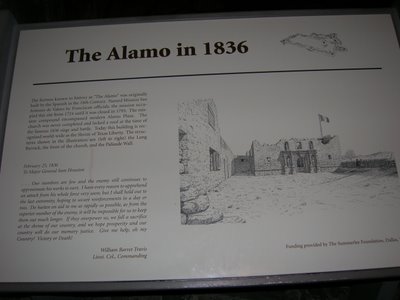Vampire Killing Kit
 Vampire Killing Kit
Vampire Killing KitRipley's Believe It or Not Museum
San Antonio Texas
September 2nd 2006
The sign reads:
"Created in the 1840's, this kit was to be used by travelers in Transylvania should they meet up with vampires! The kit contains everything a person needs to subdue a vampire including an ivory cross, a gun, silver bullets, garlic and a wooden stake!"
Believe it... or not!
San Antonio Street Paintings
 As a friend and I were walking through downtown San Antonio tonight, we came upon a very interesting scene. On a street corner directly across from the Alamo, there were two men sitting on metal chairs between old-style rotating police siren lights, with heavy metal music blaring loudly. Both were wearing respirators and goggles. They were painting feverishly, using spray paint, sponges, razors, and blow torches. The scene was energetic, fast paced, somewhat futuristic, and surreal. Here are some of the paintings that one of the artists was creating.
As a friend and I were walking through downtown San Antonio tonight, we came upon a very interesting scene. On a street corner directly across from the Alamo, there were two men sitting on metal chairs between old-style rotating police siren lights, with heavy metal music blaring loudly. Both were wearing respirators and goggles. They were painting feverishly, using spray paint, sponges, razors, and blow torches. The scene was energetic, fast paced, somewhat futuristic, and surreal. Here are some of the paintings that one of the artists was creating. The Alamo - Historical Marker
 The Alamo - Historical Marker
The Alamo - Historical MarkerSan Antonio Texas
02 September 2006
"The fortress known to history as "The Alamo" was originally built by the Spanish in the 18th Century. Named Mission San Antonio de Valero by Franciscan officials, the mission occupied this site from 1724 until it was closed in 1793. The mission compound encompassed modern Alamo Plaza. The church was never completed and lacked a roof at the time of the famous 1836 seige and battle. Today this building is recognized world-wide as the Shrine of Texas Liberty. The structures shown in the illustration are (left to right) the Long Barrack, the front of the church, and the Palisade Wall."
San Antonio Riverwalk Rio Taxi
 San Antonio Riverwalk
San Antonio RiverwalkSeptember 2nd 2006
If you ever go to the San Antonio Riverwalk, I highly recommend taking the river tour via the Rio Taxi. The tour is very inexpensive, and you get an overview of the major sites on the riverwalk from their knowledgable and friendly tour guides. This is a picture of one of the dinner tours. You can choose a tour with or without a meal included.
The Acequias of San Antonio - Historical Marker
 San Antonio River Walk
San Antonio River WalkSeptember 2nd 2006
"San Antonio's original water system, started in 1718, consisted of eight acequias, or canals, taking water from the San Antonio River and San Pedro Creek. These acequias extended 15 miles from the headwaters of the San Antonio River to the five Spanish missions, including the Alamo. Segments of the original system are still operational."



















